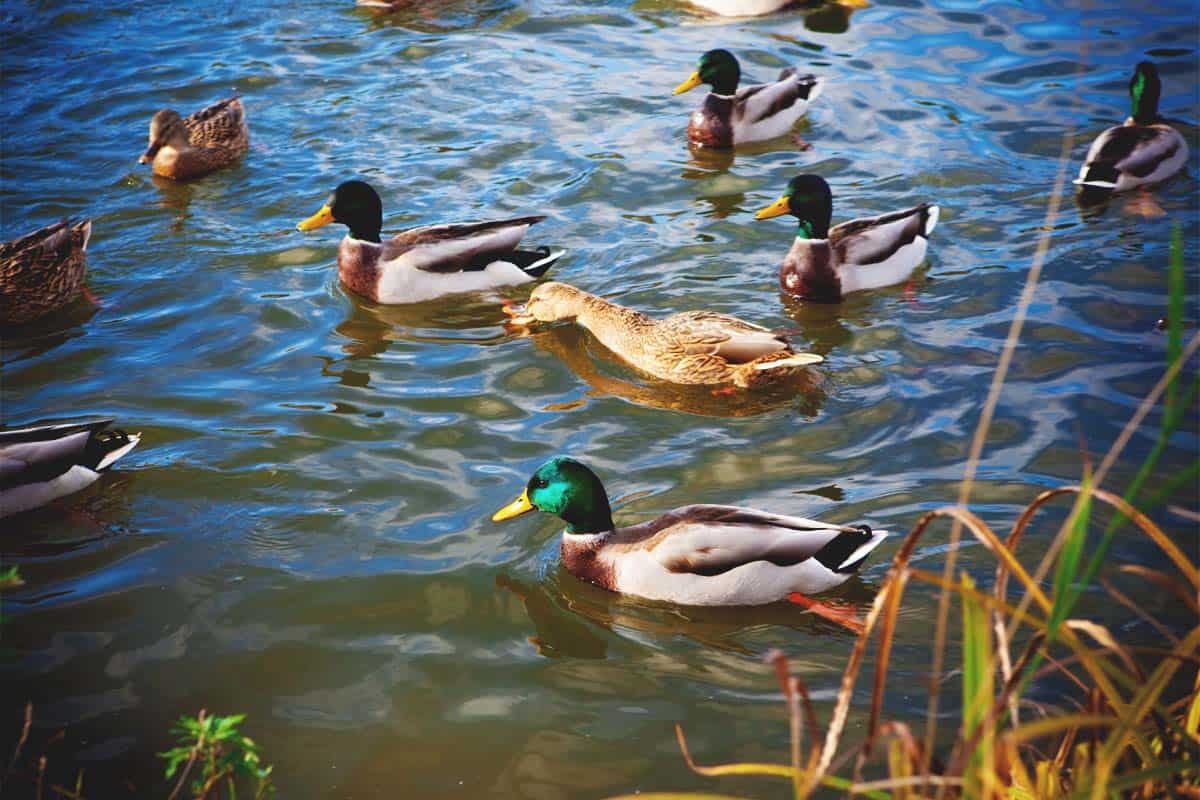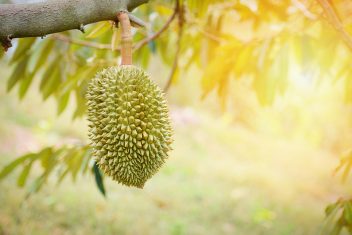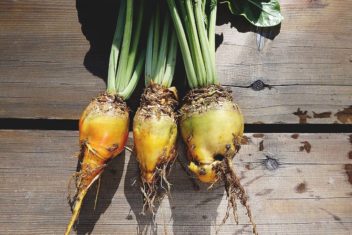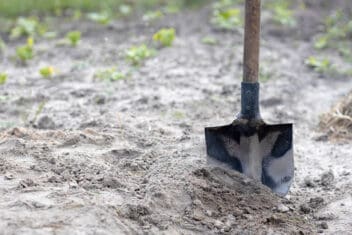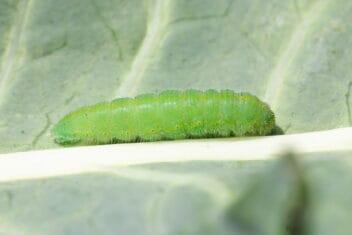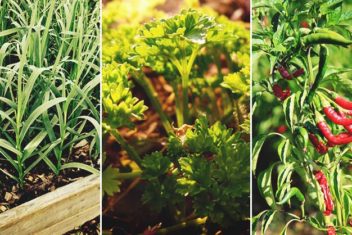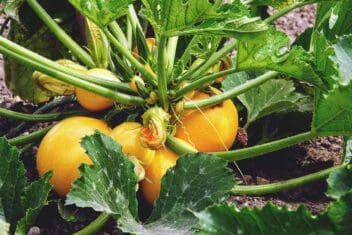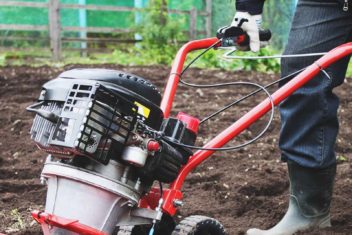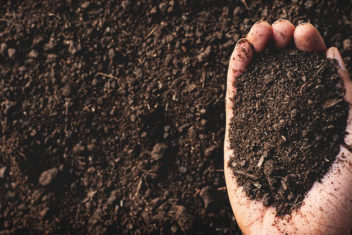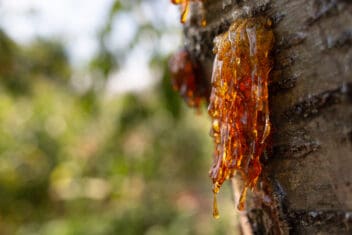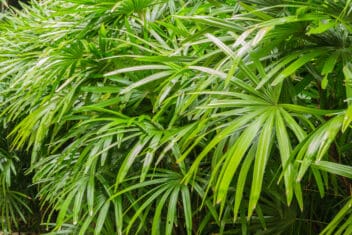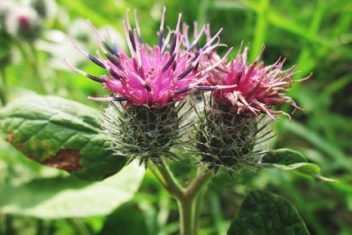It’s easy to use ducks to directly apply manure in land-based systems. Basically, all you need to do is confine ducks where you want them to fertilize and let them eat, drink, be merry, and poop (a lot). We even wrote about this in a previous post on how to use duck poop as fertilizer.
But what if you give your ducks a pond and they do a large majority of pooping in the water? Then, how do you harvest and use all that manure-water on the homestead?
This, my fellow duck-loving homesteaders, is where the following article fits into your duck keeping repertoire. It’s all about using duck poop collected in water to grow plants at home.

What is ‘Duckquaponics?’
Duck manure, collected in water, can be used in hydroponic, aquaponic, and aquaculture systems. It can be a key component in maintaining fertile and productive wetlands. It can also be used for field irrigation.
So, really, the term ‘duckquaponics’ is just an easy catch-all for the many ways you can put poopy water to work on your homestead.
The Mineral Benefits of Duck Manure
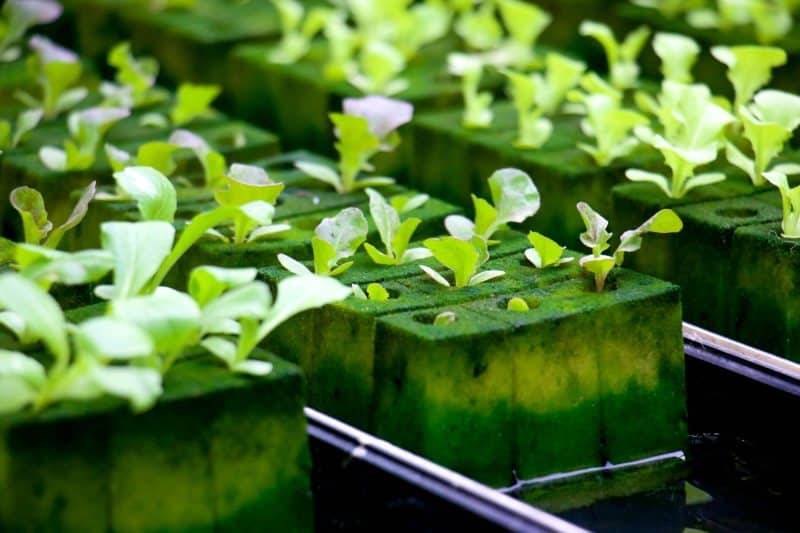
Before we get into how duck manure fits into all these water-based agricultural systems, I want to explain a few things I’ve learned about duck manure that helps me use it effectively on my homestead.
1. Nitrogen (N)
Just like chickens, a duck’s poop and their urine all come out together in one package rather than being two distinct processes. That means that duck poop contains both manure and urea found in urine.
In most manures, the nitrogen volatilizes and evaporates when exposed to air. That means up to 50% of the solid nitrogen can be lost in just the first day. Plus, the liquid parts are rapidly dispersed into the ground or bedding where it is usually lost or evaporates.
When ducks poop in the water, the nitrogen is better preserved. It doesn’t volatilize in contact with air and is instead slowly decomposed by bacteria in the water. Even after several days, as much as 70% of the nitrogen can be retained in the water.
2. Phosphorous and Potassium (P and K)
Duck manure also contains phosphorus and potassium required by plants. In its wet form, it tends to have similar quantities of P and K as it does nitrogen. That makes it almost like a balanced fertilizer (e.g. an organic 4-4-4).
Dried duck manure, by contrast, loses lots of nitrogen, some phosphorous, and concentrates potassium. So dried duck manure is more like a 1-3-6 organic fertilizer.
Over time, applying such high quantities of P and K, as are typical of dried duck manure, can lead to nutrient overload. Excess P in particular can prevent a plant from uptaking other key nutrients like calcium.
Using liquid duck manure as a fertilizer, you get a better balance of nutrients over time. That makes it easier to use things like good crop rotation and directed cover crops to keep your organic garden from becoming toxic.
3. Trace Minerals
Besides pooping in their water, ducks also backwash mud and plant parts into it. I haven’t been able to find any scientific evidence about why they do this. However, I’ve noticed they do it big time in clean water and very little in natural pond water that is already full of bacteria.
My personal theory is that ducks dirty their water to incorporate beneficial bacteria that will help decompose their manure. Since they drink and bathe in the water they poop in, that seems like a smart natural strategy for a duck.
Whether or not my theory is right, the simple fact is that by backwashing, ducks make their pond water even more beneficial for plants. This natural duck behavior adds beneficial bacteria and trace nutrients to the water that aren’t present in manure alone.
Manure Quantity In Water

The big challenge with using duck manure in water-based agriculture is that it’s hard to know exactly how many nutrients make it into your water. For example, an average 4-pound duck will produce a bit over 1/3 of a pound of poop per day.
That sounds like a lot. But since ducks are semi-aquatic animals some of that will come out on land and some will be in the water.
How to Increase Capture Rates
– Specific Duck Breeds
You can increase your capture rate by choosing duck breeds that love to swim. For example, Runners and Muscovies tend to swim the least on my homestead. Pekins, Rouens, White-crested, Anconas, Cayugas, and Dutch hookbills seem impossible to keep from the water.
– Frequently Add Water
Even with ducks that love to swim, you can increase your odds of collecting their manure in water by filling your pond frequently. Fresh water is a natural lure for ducks.
– Include a Fountain
Also, ducks love moving or splashing water. So, adding a sprinkler fountain and turning it on periodically can draw them back to the pond more often.
Water Volume per Ducks
Right-sizing your water quantity is also key. The size of your water source will vary by the number of ducks and which kind of water-based agricultural system you are using your duck manure to fertilize.
Big Natural Ponds
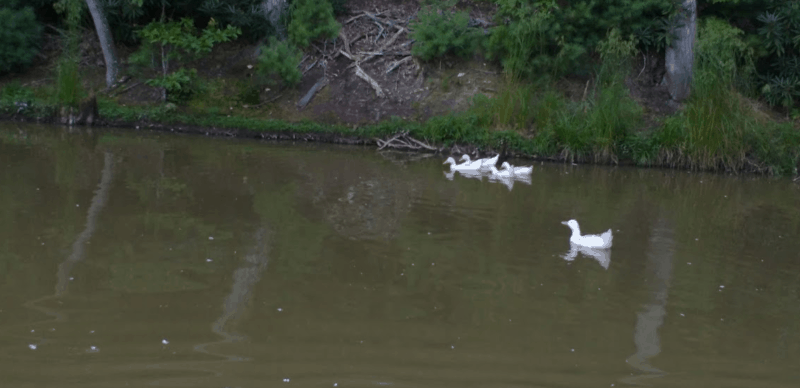
If you just want a thriving natural pond system, suggestions on numbers of ducks range from 5 – 15 ducks per acre. The actual quantities of ducks you need vary based on the depth of your pond, the amount of wildlife on the edges, how established your boggy areas are, and your rate of fresh water inputs.
Intensive Manure Collection
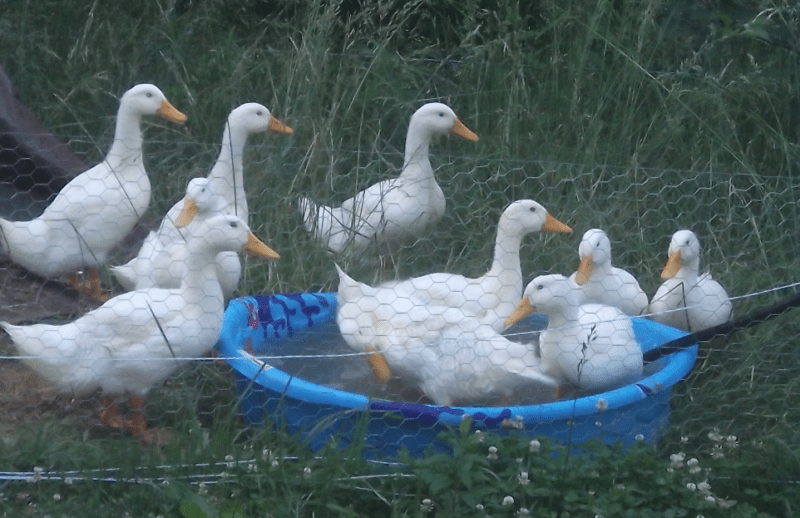
For more intensive agricultural production systems, such as using duck manure water for hydroponics or aquaponics, you’ll probably use a small pond, emptied or filtered frequently.
In my applications, I’ve had good luck giving ducks roughly a gallon of water per pound of their body weight per day. For an 8-pound Pekin, I would give them about eight gallons of fresh or filtered water to poop in daily.
A 3-foot diameter kiddie pool filled eight inches deep holds about 35 gallons. So, for me, that would be the perfect size collection container for four adult Pekins. Or, if I had a 100-gallon pond, for those same four Pekins, I would just drain it less frequently to capture more manure in a larger vessel.
You have to balance your needs of collecting manure with the ducks’ needs of having clean drinking water sources. Getting the right water to manure ratio is all about putting the health of your ducks first, while also maximizing manure collection.
Experimentation Required
There are so many variables such as the pH of your water source, the kind of ducks you use, what you feed them, what kind of stuff they backwash into the water, how much manure you actually collect in your chosen water source, and more. So, you are going to have to do some experimentation to determine what works best in your particular conditions.
Starting small with just a few ducks, trying different pond container sizes, and carefully monitoring the health of your ducks and the plants you fertilize is critical.
Nutrient and pH testing
You may also want to do some testing to see what’s in your duck manure water. Home soil test kits are designed to measure water-soluble nutrients and properties. So, you can use those tests to check the pH and N-P-K of your duck manure water. Or you can purchase instruments or test kits designed to use with hydroponic systems.
Then you can use that information to adjust the pond size, duck stocking density, how often you drain the water, and other factors to get the right nutrient quantity for whichever water-based agricultural system you are using and what your plants need.
The Different Duckquaponic Options
Now, with all that background, let’s cover some of the water-based agriculture systems that can be adapted to work with duck manure water.
1. Hydroponics
Hydroponic gardening is basically a plant growing method whereby you replace the soil with some sort of sterile root holding medium. Then, you feed plants with a water-soluble nutrient mix. The plants absorb nutrients directly from the water.
Once you get your duck manured water collection practices right, then you can use that liquid as your nutrient solution and water source in hydroponic systems.
Some hydroponic systems can become clogged by the particle size in your duck water. You will probably need to use a filter to remove debris before putting duck water into your system. All that filtered matter can then go on your outdoor planting areas as a low nutrient soil amendment.
When using duck manure water in hydroponics, your equipment gets dirty faster. It’s also trickier to maintain the right nutrient levels and pH than when using synthetic chemicals. So, aquaponics is often an easier system to use duck manure in than hydroponics.
2. Aquaponics
Aquaponics operates much like hydroponics using tanks and pumps. However, it has an additional fish aquarium component added to it. Essentially, fish kept in a tank poop into water that is then used as the nutrient solution for the plants. These systems also usually have a worm bed component to decompose the non-water-soluble aspects of fish manure.
When using ducks for aquaponics, the ducks essentially replace the fish as the fertilizer source. Since aquaponic grow beds are already adapted for filtering manure and returning fresh water, these systems can be a lot easier to adapt to using ducks.
Here’s a great example using recycled materials.
Ducks also have the added benefits of not needing water aeration to survive. That means if your power goes out, ducks won’t die from lack of oxygen like fish. Ducks are also cold hardy so you just have to keep temperatures ideal for your plants, not your ducks too.
3. Aquaculture
Hydroponic and aquaponic systems are used to grow soil-based plants in water. Aquaculture, by contrast, involves growing plants and animals that specifically thrive in water in production environments. For example, fish hatcheries, salmon, oyster and algae farms, or aquatic plant growers fall into this category.
Duck manure water can be used in any kind of aquaculture. For example in fish hatcheries, the bacteria and algae that fish feed on require nutrient sources to survive. Duck manure often works perfectly as a feedstock for lower-level life forms that then feed the fish.
In a homestead scenario, duck manure water is often most useful in growing aquatic plants. Things like duckweed and water hyacinth or Azolla can be grown, dried, and incorporated into other livestock feeds. Or, they can be used to produce high-quality compost.
4. Wetlands
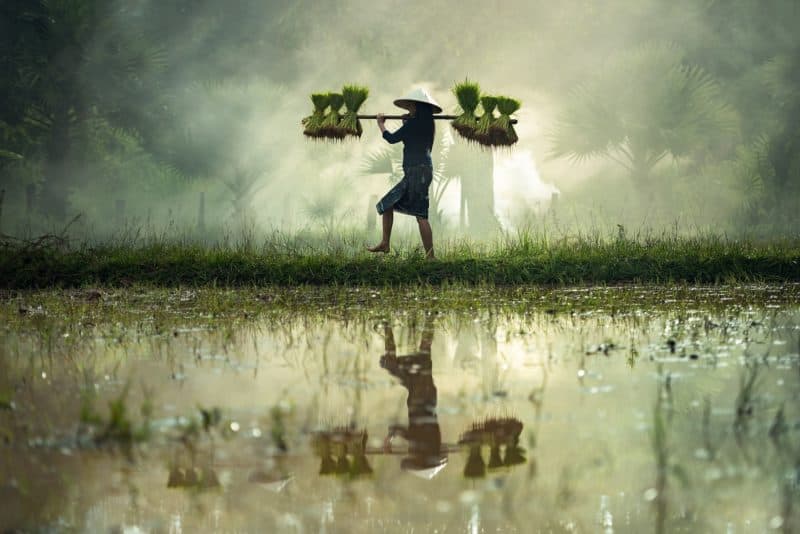
Wetlands are some of the most productive systems for food production. Things like rice, cranberries, watercress, cattails, and fish can all be grown in wetlands.
Duck manure water can be the perfect nutrient source for high-density wetland planting systems. Keep in mind, ducks will eat or trample some of your plants. So, you may want to keep the ducks away from your crop wetlands and instead transport the manure water to the plants.
5. Irrigation Applications
Finally, the simplest way to use duck manure water in agriculture is through irrigation. Basically, your duck pond water is used to water your soil. That transmits the nutrients and the moisture plants need in one application.
Unfortunately, you can’t use duck manure water with traditional irrigation systems like soaker hoses or drip tape because the particle size is too large. Those systems will quickly clog and become useless. Instead, you need to go rustic.
– Flood/Furrow Irrigation
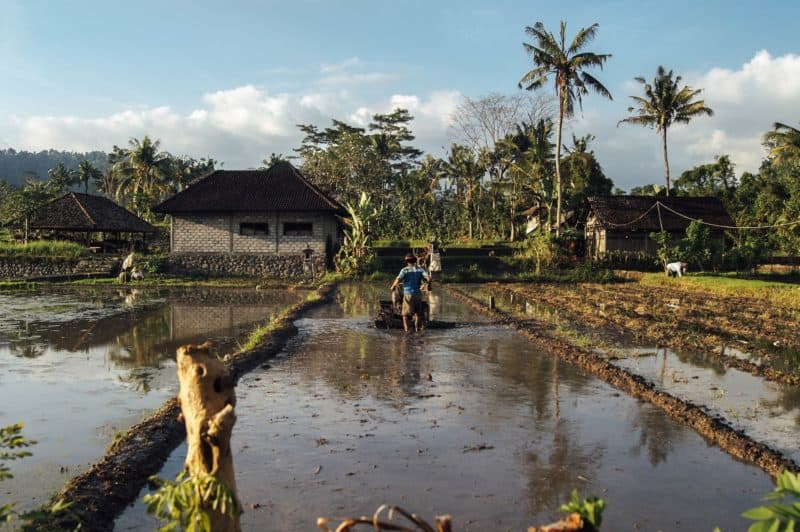
Think of the Nile flooding the banks of Egypt, and that post-flood land being used to grow vegetables. Flood or furrow irrigation is about as old as agriculture and works great with duck manure.
Basically, all you need to do is unleash a load of duck manure water on a flood planned garden area. Before planting you soak the entire beds. After planting, you may just irrigate channels between the beds so roots can reach out to those channels to get moisture.
You can design rain-fed gravity-based systems or use pumps to move the duck manure water. Either way, the benefit of this system is that irrigating with duck manure water dramatically improves your soil much faster than just using tap or rainwater.
– Score and Pour
My favorite method for the beginner is what I call score and pour. Fill a kiddie pond in an area uphill of your fruit trees or other perennials. Ducks will naturally flock to the water.
Once the water is good and dirty, dump it so it drains to the planting areas down below. Then, move the pond, refill and nourish a new area.
Alternatively, you can scoop out the water with a bucket or watering can and water manually.
A Final Word on Duckquaponic Safety Risks
I am a huge fan of all sorts of duckquaponic applications and I employ several of them on my homestead. However, I do want to warn you that using fresh manure to produce food for human consumption comes with risks. Manure is often hosting E. coli and Salmonella and other dangerous pathogens.
Farmers selling food to others are required to apply fresh manure at least 6 months before the harvest date to reduce pathogen risks. Home gardeners are generally encouraged to compost then age manure for at least 6 months before using it in areas where food is grown.
You can minimize risks by making sure the fresh manure only goes to the roots and does not have contact with plant leaves. You can cook your vegetables to heat treat pathogens. You can also use fresh manure only for taller plants such as fruit trees or corn so manure contact with the edible portions is limited.
These methods will limit your risks. Ultimately though, you’ll want to do your own research. Evaluate the risks of your applications. Then, make your own decisions on whether using fresh duck manure, captured in water is right for your homestead.
